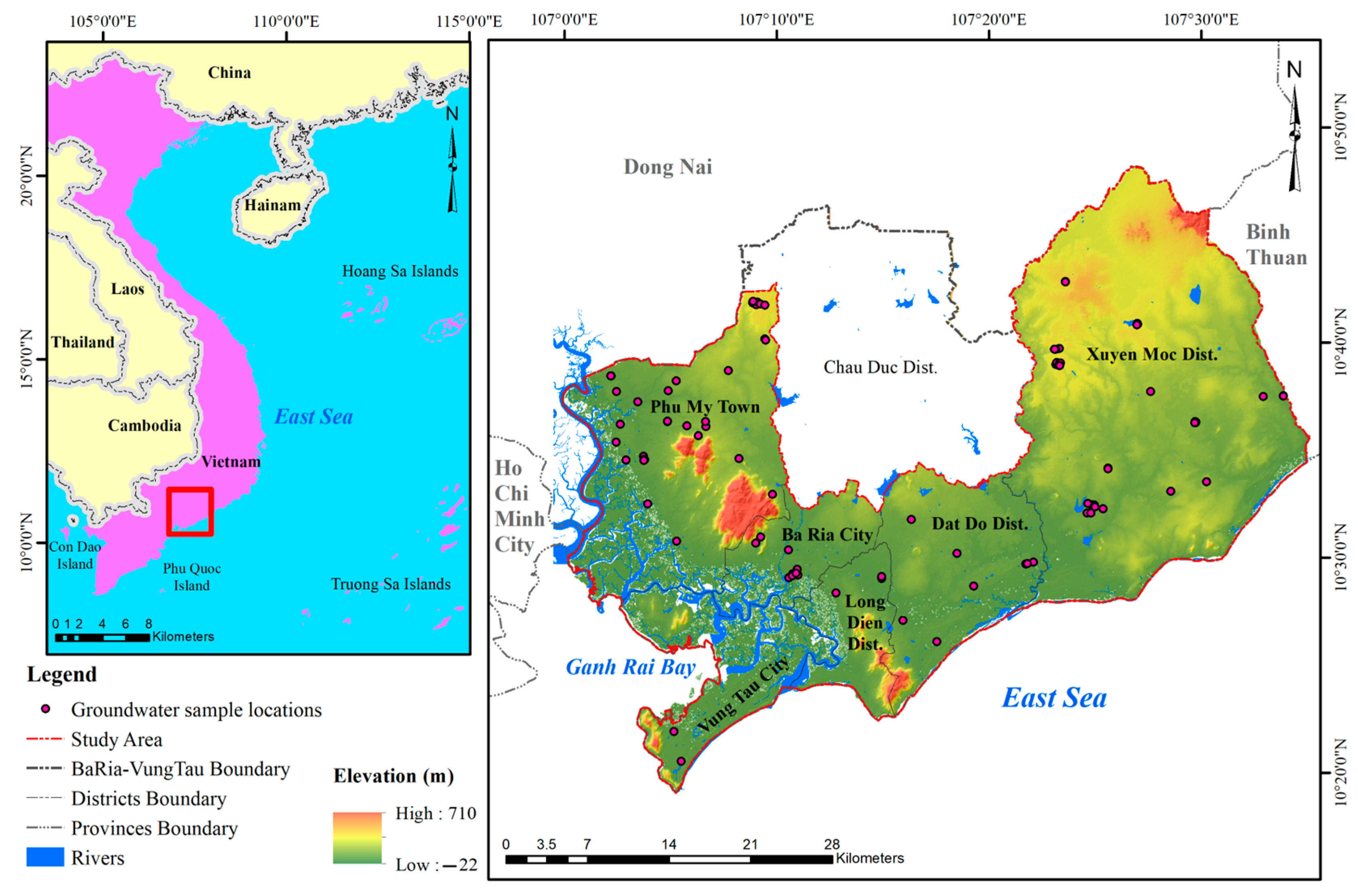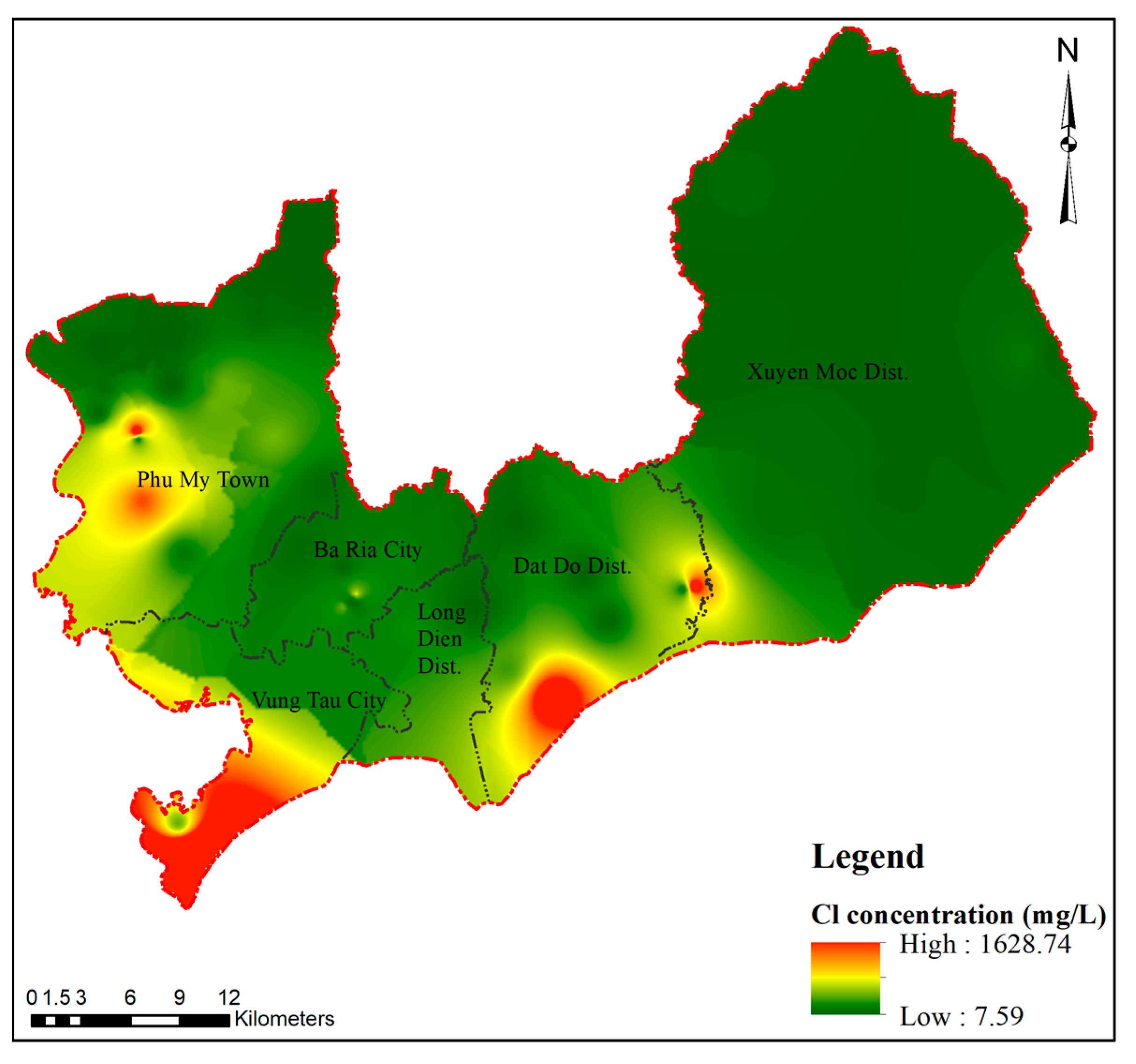Assessment of Pleistocene Aquifer Vulnerability to Saline Intrusion in the Coastal Region of Ba Ria-Vung Tau Province Using GIS and Entropy-GALDIT
Abstract
1. Introduction
2. Materials and Methods
2.1. Study Area
2.2. GALDIT Index
2.3. Entropy—Weighted GALDIT
2.4. IDW (Inverse Distance Weighting) Interpolation Algorithm
3. Results
3.1. Component Parameter Layers in GALDIT
3.1.1. Groundwater Occurrence (G)
3.1.2. Aquifer Hydraulic Conductivity (A)
3.1.3. Height of Groundwater Level above Sea level (L)
3.1.4. Distance from the Shore (D)
3.1.5. Impact of Existing Status of Seawater Intrusion (I)
3.1.6. Thickness of the Aquifer (T)
3.2. GALDIT Framwork
3.3. Vulnerability Zoning to Seawater Intrusion in Coastal Areas with Entropy-GALDIT
4. Discussion and Conclusions
Author Contributions
Funding
Institutional Review Board Statement
Informed Consent Statement
Data Availability Statement
Conflicts of Interest
References
- Kazakis, N.; Busico, G.; Colombani, N.; Mastrocicco, M.; Voudouris, K. Limitations of GALDIT to map seawater intrusion vulnerability in a highly touristic coastal area. IOP Conf. Ser. Earth Environ. Sci. 2018, 191, 012050. [Google Scholar] [CrossRef]
- Chronidou, D.; Tziritis, E.; Panagopoulos, A.E.; Oikonomou, K.; Loukas, A. A Modified GALDIT Method to Assess Groundwater Vulnerability to Salinization—Application to Rhodope Coastal Aquifer (North Greece). Water 2022, 14, 3689. [Google Scholar] [CrossRef]
- Hussain, M.S.; Abd-Elhamid, H.F.; Javadi, A.A.; Sherif, M.M. Management of Seawater Intrusion in Coastal Aquifers: A Review. Water 2019, 11, 2467. [Google Scholar] [CrossRef]
- Werner, A.D.; Simmons, C.T. Impact of Sea-Level Rise on Sea Water Intrusion in Coastal Aquifers. Ground Water 2009, 47, 197–204. [Google Scholar] [CrossRef] [PubMed]
- Su, Z.; Wu, J.; He, X.; Elumalai, V. Temporal Changes of Groundwater Quality within the Groundwater Depression Cone and Prediction of Confined Groundwater Salinity Using Grey Markov Model in Yinchuan Area of Northwest China. Expo. Health 2020, 12, 447–468. [Google Scholar] [CrossRef]
- Chachadi, A.; Lobo-Ferreira, J. Sea water intrusion vulnerability mapping of aquifers using GALDIT method. Coastin 2001, 4, 7–9. [Google Scholar]
- Ferreira, A.; Chachadi, A. Assessing aquifer vulnerability to sea-water intrusion using GALDIT method: Part 2–GALDIT Indicators Description. In Proceedings of the 4th Inter Celtic Colloquium on Hydrology and Management of Water Resources, Guimarães, Portugal, 11–14 July 2005. [Google Scholar]
- Saravanan, S.; Parthasarathy, K.; Sivaranjani, S. Assessing coastal aquifer to seawater intrusion: Application of the GALDIT method to the Cuddalore Aquifer, India. In Coastal Zone Management; Elsevier: Amsterdam, The Netherlands, 2019; pp. 233–250. [Google Scholar]
- Kardan, M.H.; Jafari, F.; Javadi, S. Vulnerability evaluation of a coastal aquifer via GALDIT model and comparison with DRASTIC index using quality parameters. Hydrol. Sci. J. 2017, 62, 137–146. [Google Scholar]
- Mirzavand, M.; Ghasemieh, H.; Sadatinejad, S.J.; Bagheri, R.; Clark, I.D. Saltwater intrusion vulnerability assessment using AHP-GALDIT model in Kashan plain aquifer as critical aquifer in a semi-arid region. Desert 2018, 23, 255–264. [Google Scholar]
- Yang, J.; Tang, Z.; Jiao, T.; Malik, M.A. Combining AHP and genetic algorithms approaches to modify DRASTIC model to assess groundwater vulnerability: A case study from Jianghan Plain, China. Environ. Earth Sci. 2017, 76, 426. [Google Scholar] [CrossRef]
- Dweiri, F.; Kumar, S.; Khan, S.A.; Jain, V. Designing an integrated AHP based decision support system for supplier selection in automotive industry. Expert Syst. Appl. 2016, 62, 273–283. [Google Scholar] [CrossRef]
- Chakraborty, S.; Kumar, R.N. Assessment of groundwater quality at a MSW landfill site using standard and AHP based water quality index: A case study from Ranchi, Jharkhand, India. Environ. Monit. Assess. 2016, 188, 335. [Google Scholar] [CrossRef] [PubMed]
- Bozdağ, A. Combining AHP with GIS for assessment of irrigation water quality in Çumra irrigation district (Konya), Central Anatolia, Turkey. Environ. Earth Sci. 2015, 73, 8217–8236. [Google Scholar] [CrossRef]
- Han, Y.; Zhihong, Z. Water Quality Evaluation Based on Entropy Coefficient and Blind Number Theory Measure Model. J. Netw. 2014, 9, 1868–1874. [Google Scholar]
- Bo, M.; Aminreza, N.; Saman, J. Modification of the GALDIT framework using statistical and entropy models to assess coastal aquifer vulnerability. Hydrol. Sci. J. 2019, 64, 1117–1128. [Google Scholar]
- Jeong-Seok, Y.; Yong-Wook, J.; Amos, A.; Jin-Sik, S.; Jae-Boem, L. GALDIT Modification for Seasonal Seawater Intrusion Mapping Using Multi Criteria Decision Making Methods. Water 2022, 14, 2258–2277. [Google Scholar]
- Canh, T.T.; Thao, B.N.; Vuong, T.B. Assessment of aquifer vulnerability by saltwater intrusion in Tien Giang area by GALDIT method and proposion of a monitoring system for salt intrusion. J. Min. Earth Sci. 2018, 59, 71–83. [Google Scholar]
- Long, N.P.; Dat, T.H. Application of GIS-Base GALDIT for vulnerability assessment to saltwater intrusion of Holocene coastal aquifer: A case of Quang Nam-Da Nang city, Vietnam. Vietnam J. Earth Sci. 2020, 42, 298–310. [Google Scholar] [CrossRef]
- Pham, Q.N.; Ta, T.T.; Tran, T.L.; Pham, T.T.; Nguyen, T.C. Assessment of Saltwater Intrusion Vulnerability in the Coastal Aquifers in Ninh Thuan, Vietnam. Proc. EDESUS Glob. Change. Sustain. Dev. Asian Emerg. Mark. Econ. 2019, 2, 703–712. [Google Scholar]
- Nguyen, A.H.; Tuyet, N.P.T.; Hong, M.V.T.; Khanh, L.L.; Ngoc, T.T. Application of GIS-based GADLIT model for vulnerability assessment to seawater intrusion to Aquifer Upper-Middle Pleistocene in Phu My Town, Ba Ria-Vung Tau Province of Ba Ria-Vung Tau province. VNUHCM J. Earth Sci. Environ. 2021, 5, 37–46. [Google Scholar]
- Shannon, C.E. A mathematical theory of communication. Bell Syst. Tech. J. 1948, 17, 379–423. [Google Scholar] [CrossRef]
- Department of Natural Resources and Environment of Ba Ria-Vung Tau Province. Investigation and Assessment of Salinity in Aquifers due to the Impacts of Climate Change, Sea Level Rise in Coastal Areas of Ba Ria-Vung Tau Province; Department of Natural Resources and Environment of Ba Ria-Vung Tau Province: Ba Ria, Vietnam, 2020.
- Department of Natural Resources and Environment of Ba Ria-Vung Tau Province. Operation of Groundwater Monitoring Network in Ba Ria-Vung Tau Province; Department of Natural Resources and Environment of Ba Ria-Vung Tau Province: Ba Ria, Vietnam, 2021.
- Alqurnawy, L.S.; Almallah, I.A.; Alrubaye, A. Groundwater Vulnerability Analysis via GALDIT-GIS Method to Seawater Intrusion, South of Iraq. Iraqi Geol. J. 2022, 55, 147–162. [Google Scholar] [CrossRef]
- Department of Natural Resources and Environment of Ba Ria-Vung Tau Province. Research and Construction of Groundwater Monitoring Network in Ba Ria-Vung Tau Province; Department of Natural Resources and Environment of Ba Ria-Vung Tau Province: Ba Ria, Vietnam, 2011.
- Bordbar, M.; Neshat, A.; Javadi, S.; Pradhan, B.; Aghamohammadi, H. Meta-heuristic algorithms in optimizing GALDIT framework: A comparative study for coastal aquifer vulnerability assessment. J. Hydrol. 2020, 585, 124768. [Google Scholar] [CrossRef]
- Revelle, R. Criteria for recognition of sea water in ground-waters. Trans. Am. Geophys. Union 1941, 22, 593–597. [Google Scholar] [CrossRef]






| GALDIT Model | Partition Type |
|---|---|
| >7.5 | Low vulnerability zone |
| 5–7.5 | Medium vulnerability zone |
| 2.5–5 | High vulnerability zone |
| Parameter | Weight | Range/Explanation | Rating | |
|---|---|---|---|---|
| GALDIT | Entropy-GALDIT | |||
| G—Groundwater occurrence | 1 | 0.1653 | Confined aquifer | 10 |
| Unconfined aquifer | 7.5 | |||
| Leaky confined aquifer | 5 | |||
| A—Aquifer hydraulic conductivity (m/day) | 3 | 0.1670 | >40 | 10 |
| 10–40 | 7.5 | |||
| 5–10 | 5 | |||
| <5 | 2.5 | |||
| L—Height of groundwater level above sea level (m) | 4 | 0.1675 | <1.0 | 10 |
| 1.0–1.5 | 7.5 | |||
| 1.5–2.0 | 5 | |||
| >20 | 2.5 | |||
| D—Distance from the shore (m) | 4 | 0.1671 | <2500 | 10 |
| 2500–5000 | 7.5 | |||
| 5000–10,000 | 5 | |||
| >10,000 | 2.5 | |||
| I—Impact of existing status of seawater intrusion | 1 | 0.1674 | >2.0 | 10 |
| 1.5–2.0 | 7.5 | |||
| 1.0–1.5 | 5 | |||
| <1.0 | 2.5 | |||
| T—Thickness of the aquifer (m) | 2 | 0.1657 | >10 | 10 |
| 7.5–10 | 7.5 | |||
| 5–7.5 | 5 | |||
| <5 | 2.5 | |||
Disclaimer/Publisher’s Note: The statements, opinions and data contained in all publications are solely those of the individual author(s) and contributor(s) and not of MDPI and/or the editor(s). MDPI and/or the editor(s) disclaim responsibility for any injury to people or property resulting from any ideas, methods, instructions or products referred to in the content. |
© 2023 by the authors. Licensee MDPI, Basel, Switzerland. This article is an open access article distributed under the terms and conditions of the Creative Commons Attribution (CC BY) license (https://creativecommons.org/licenses/by/4.0/).
Share and Cite
Nguyen, A.H.; Pham, K.Q.; Le, Q.H. Assessment of Pleistocene Aquifer Vulnerability to Saline Intrusion in the Coastal Region of Ba Ria-Vung Tau Province Using GIS and Entropy-GALDIT. Sustainability 2023, 15, 8107. https://doi.org/10.3390/su15108107
Nguyen AH, Pham KQ, Le QH. Assessment of Pleistocene Aquifer Vulnerability to Saline Intrusion in the Coastal Region of Ba Ria-Vung Tau Province Using GIS and Entropy-GALDIT. Sustainability. 2023; 15(10):8107. https://doi.org/10.3390/su15108107
Chicago/Turabian StyleNguyen, Au Hai, Khanh Quoc Pham, and Quang Huu Le. 2023. "Assessment of Pleistocene Aquifer Vulnerability to Saline Intrusion in the Coastal Region of Ba Ria-Vung Tau Province Using GIS and Entropy-GALDIT" Sustainability 15, no. 10: 8107. https://doi.org/10.3390/su15108107
APA StyleNguyen, A. H., Pham, K. Q., & Le, Q. H. (2023). Assessment of Pleistocene Aquifer Vulnerability to Saline Intrusion in the Coastal Region of Ba Ria-Vung Tau Province Using GIS and Entropy-GALDIT. Sustainability, 15(10), 8107. https://doi.org/10.3390/su15108107






